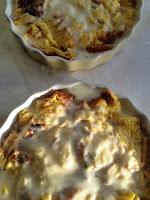I bought a Panettone for half price. Of course it sat on the sideboard and was picked at.
I had a carton of cream in the fridge also leftover so made a version of bread and butter pudding using the Panettone.
Panettone Pud Recipe
Panettone (I had about three quarters leftover)
450 ml milk
200 ml cream
3 large eggs
75g sugar
I used two quiche dishes measuring 21cm diameter.
 Slice the Panettone up into small pieces and pack it into the two quiche dishes.
Slice the Panettone up into small pieces and pack it into the two quiche dishes.I didn't butter it as felt it was rich enough.
Pour the milk and cream into a saucepan and bring to just under the boil, remove from the heat and set aside.
Put the eggs and sugar into a bowl over a saucepan of water. As the water underneath heats up, whisk the eggs and sugar together.
Continue to whisk until the egg mixture is thick and creamy.
When the milk and cream mixture has cooled slightly add the egg mix into the milk and cream and continue to whisk.
Divide the custard mixture between the two dishes. Press the panettone down into the custard mix with the back of a spatula.
Place in a pre-heated oven at 180 deg for 35 minutes until golden and puffed up.
Serve with whipped cream.





